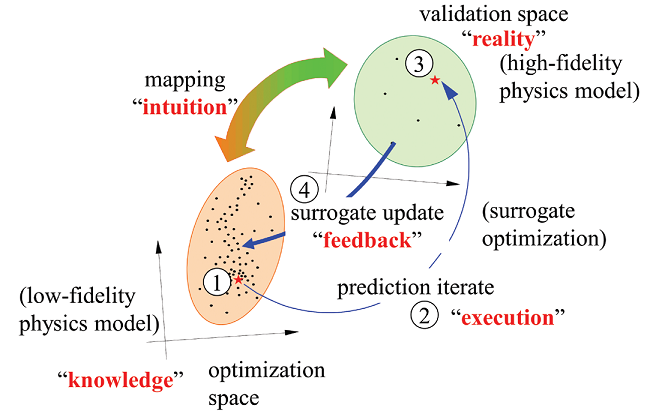Space Mapping Technology
The space mapping approach to engineering model enhancement and design optimization intelligently links companion "coarse" (ideal or low-fidelity) and "fine" (practical or high-fidelity) models of different complexities. Examples include full-wave electromagnetic (fine) simulations with empirical circuit-theory based (coarse or surrogate) simulations, or an engineering device under test coupled with a suitable simulation surrogate. Space mapping arises out of the engineer's "feel" for solving problems. Each of the four steps of a space mapping process mimics an expert's activity, as shown below.

Our methodology has been adopted for diverse design applications: electronic components, antennas, microwave circuits, magnetic systems, civil, mechanical, chemical, and aerospace engineering structures, including automotive crashworthiness design. Space mapping facilitates efficient optimization while avoiding direct expensive optimization of the fine model. It is a simple CAD methodology, which closely follows the traditional experience and intuition of engineers, yet is amenable to rigorous mathematical treatment.
Following the original concept of Bandler in 1993, algorithms have utilized Broyden updates (aggressive space mapping), trust regions, and artificial neural networks. Recent developments include implicit space mapping, in which we allow preassigned parameters not used in the optimization process to change in the coarse model, and output space mapping, where a transformation is applied to the responses of the model. The tuning space mapping process exploits tuning ports and simulator-based models to construct a tuning model. The relevant tuning model is based directly on the fine model, in which tunable elements are inserted into appropriate tuning ports. Simple space mappping frameworks have been implemented in commercial software packages such as Agilent ADS. Our new understanding of space mapping links the process to cognition and human evolution.
We have invented the so-called "cheese-cutting," "wedge-cutting," "cake-cutting," "shoe-selection," and other simple illustrations of space mapping algorithms.
Diverse Implementations of Space Mapping
Space mapping application to handset antenna design (Tu et al., Canada, 2013).
Space mapping application to wing aerodynamic shape optimization (Leifsson et al., Iceland, 2013, 2014).
Space mapping application to statistical modeling of passive components (Zhang et al., Freescale Semiconductor Inc., USA, 2012).
Space mapping application to optimization of a marine ecosystem model (Prieß and Slawig, Germany, 2012).
Space mapping application to a feasibility study for transport processes coming from the fields of fluid dynamics, semiconductors and radiation (Marheineke and Pinnau, Germany, 2012).
Space mapping application to EGG source analysis (Crevecoeur et al., Belgium, 2008).
Space mapping application to optimization of dielectric resonator filters and multiplexers (Com Dev, Cambridge, Canada, 2003-).
Space mapping application to development of new library models for wireless components (Philips, The Netherlands, 2001-).
Space mapping application to SAAB 9-3 Sport Sedan Crashworthiness design (Redhe et al., Sweden, 2001-).
In 2005 we announced SMF, the world's first friendly system for engineering modeling, optimization and statistical analysis based on Space Mapping. Matlab based, SMF drives the commercial solvers MEFiSTo, Sonnet em, ADS, and FEKO. SMF also features interactive Space Mapping.
Knowledge-Based Modeling
We have forged links between space mapping technology and artificial neural network (ANN) technology for device modeling and circuit optimization. This is related to the knowledge based neural network (KBNN) methodology developed at Carleton University by Dr. Q.J. Zhang and his group.
Cognition-Driven Modeling
We are currently exploring "Cognition-Driven Modeling and Optimization Technology for Multidisciplinary Design of High-Frequency Components and Communication Subsystems" with Dr. Q.J. Zhang and his group.
Historical Notes on Space Mapping
Space Mapping (Bandler, Biernacki and
Chen)
Space Mapping Based Neuromodeling
